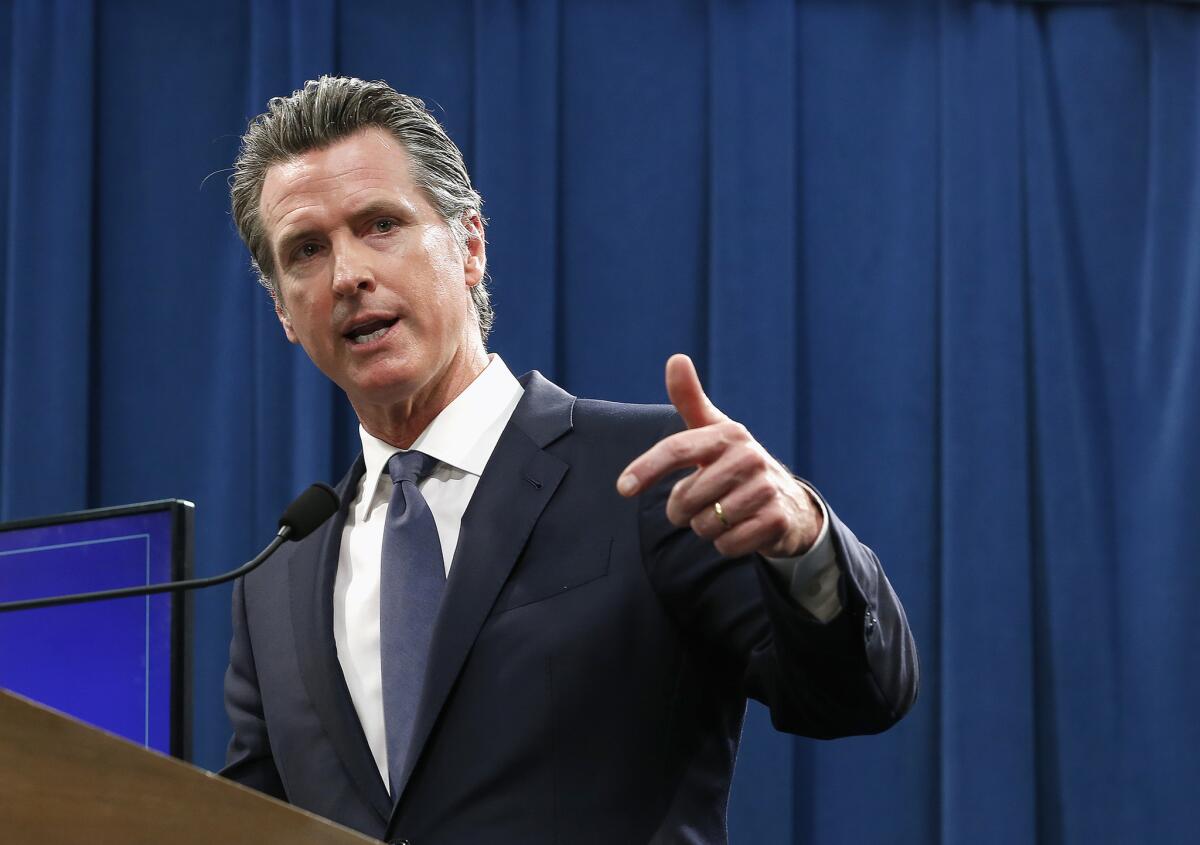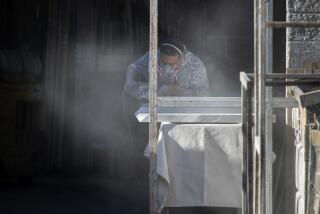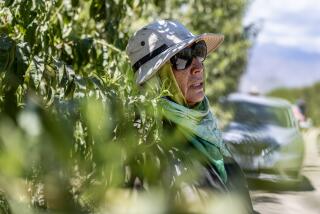California worker safety agency ‘missing in action’ during the coronavirus, critics say

- Share via
WASHINGTON — As Gov. Gavin Newsom attempts to rein in the state’s rising coronavirus cases, the agency responsible for keeping California workers safe spent the July 4 holiday visiting more than 1,000 businesses to ensure they were following safety guidelines.
Newsom hailed the multi-agency effort as a success — saying the resulting 52 citations showed most businesses were following the rules. Worker rights’ advocates, however, called the action more of a publicity stunt that distracts from the truth: An agency once considered among the best of its kind nationwide has largely abandoned in-person inspections since the pandemic began, potentially endangering the lives of millions of workers across California.
“The administration appears to be concerned with optics, not substance,” said Jeff Ruch, who leads the Pacific branch of Public Employees for Environmental Responsibility, or PEER. The group’s members include current and former public employees, including those at California’s Division of Occupational Safety and Health, better known as Cal/OSHA.
Cal/OSHA employees required to carry out the July 4 blitz have not been tested for COVID-19, Ruch said. “They could be making a bad situation worse,” he said.
Emails sent to agency employees ahead of the blitz were shared with The Times, including one from agency chief Doug Parker saying Newsom had enlisted Cal/OSHA to “get the word out” about the governor’s efforts to keep businesses in line.
Parker mandated employees work overtime during the 72-hour holiday weekend to visit select businesses across the state and, according to another email from an agency policy advisor, “flag a few high-profile cases and well-known spots in Los Angeles and the Bay Area” to help the governor “capture media attention.”
The businesses targeted in the governor’s blitz were mostly commercial storefronts such as grocery chains, big-box stores and restaurants. The centers of the state’s largest outbreaks to date have been workplaces such as nursing homes, meatpacking plants, hospitals and prisons, which have struggled to contain infections despite intervention from local and state authorities.
Cal/OSHA has more than 50 inspector vacancies out of an authorized 270 positions. According to an analysis by PEER, fewer than 50 inspectors are conducting on-site visits for all of California.
The group also claims the agency has racked up a growing backlog of 3,000 complaints of unsafe working conditions and “a couple hundred” delayed investigations into workplace fatalities, illnesses and injuries, which are required by law to be inspected promptly in person.
Agency spokeswoman Erika Monterroza disputed PEER’s claims of a massive backlog. As of July 12, Cal/OSHA has responded to more than 3,200 complaints out of a total of 3,871, she said in an email.
Monterroza would not comment on PEER’s claim that fewer than 50 staffers are conducting in-person inspections across the state. She also declined to answer questions relating to the availability of COVID-19 testing for Cal/OSHA employees.
“While it is extremely important to Cal/OSHA to fill all vacancies, we do not let open positions stop us from fulfilling our mandate and engaging with as many employers and workers as possible,” Monterroza wrote. “We always take employee complaints seriously and address them appropriately based on the severity of the hazard.”
The governor’s office declined to comment on vacancies at Cal/OSHA as well as the agency’s capacity to handle complaints.
Vacancies and cuts at Cal/OSHA aren’t new, critics acknowledge, but have worsened under several administrations.
Now, when the agency’s mission is especially critical, the long-standing cutbacks threaten the safety and health of workers, advocates say.
“The disinvestment in Cal/OSHA is long-standing and this is the moment to reverse it,” said Stephen Knight, director of Worksafe, a California-based nonprofit that advocates for stronger workplace safety. “We need a whole new Cal/OSHA, bigger and stronger and working with employers and workers to help us find our way through this crisis.”
By PEER’s count, Cal/OSHA has just 1 inspector for every 99,000 workers in the state — far below the ratios for Washington state, which has 1 inspector for every 25,000 workers, and Oregon, which has 1 inspector for every 22,000 workers.
The pandemic’s impact has been most keenly and disproportionately felt by communities of color, particularly Black and Latino workers, Knight said.
Since the pandemic, the agency has shifted how it handles complaints — moving away from physically inspecting workplaces.
In an email to The Times in early June, Cal/OSHA spokesman Frank Polizzi said the agency was receiving more complaints “than can be investigated in person” and had pivoted to doing so remotely using letter investigations.
Instead of on-site visits, which are “technical, complex and time-consuming,” letter investigations allow agency staff to reach out to employers “via phone and letter to get them to implement COVID-19 precautions,” Polizzi explained.
To date, Cal/OSHA has conducted 3,218 letter investigations compared with 283 in-person inspections.
Former Cal/OSHA investigator Garrett Brown, who retired in 2014 after 20 years with the agency, expressed skepticism about the effectiveness of remote investigations and criticized the number of inspectors willing to conduct on-site visits. The agency’s workforce, Brown said, is supposed to be trained and equipped to deal with all types of serious occupational hazards, including infectious environments.
Brown runs a website called Inside Cal/OSHA, which has tracked what he says is the agency’s decline over the years including persistent vacancies.
“Cal/OSHA used to be so much better than federal OSHA,” but now, Brown said, the agency was “indistinguishable” after years of being “starved to death.”
Federal OSHA officials have yet to do much beyond issue voluntary safety guidelines during the pandemic, encouraging states to take their own approach. In 2017, the Trump administration sidelined the federal agency from creating workplace safety rules for infectious airborne diseases, such as COVID-19.
A provision protecting some workers from airborne infections has been on the books in California since 2009. Under the state policy, employers must reduce healthcare workers’ exposure to airborne diseases, including tuberculosis and pandemic influenza, regardless of whether they work in a hospital or a prison. Enforcement of that policy, however, has been lacking, according to worker rights’ advocates and nursing union officials.
Worksafe filed an emergency petition with the state in May to extend those protections to all workers. Last year, the group successfully argued for emergency safety standards to protect workers against smoke during wildfires.
California has yet to act on Worksafe’s petition, but other states, including Virginia and Oregon, are moving forward with pandemic workplace protections.
Knight was less harsh in his assessment of Cal/OSHA than Brown, but agreed that the agency is far from where it needs to be. “If you measure [Cal/OSHA] by the standard of what we’re seeing by the federal government, California looks good,” he said, “but that’s grading on a very sharp curve.”
Are you facing any workplace safety issues? The Los Angeles Times wants to hear from you. Contact Jie Jenny Zou at [email protected] or leave us a tip anonymously at http://ziira.shop/tips/
More to Read
Get the L.A. Times Politics newsletter
Deeply reported insights into legislation, politics and policy from Sacramento, Washington and beyond. In your inbox three times per week.
You may occasionally receive promotional content from the Los Angeles Times.











